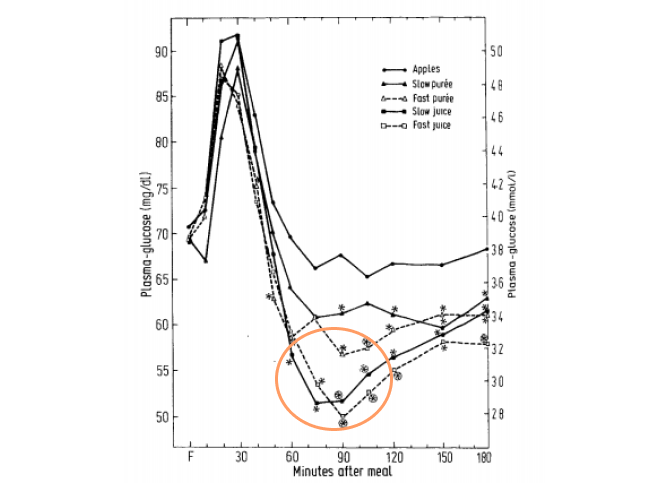What is an Apple?
Expanding on the idea of epistemic arrogance , let me ask you this — What is an apple?
The average person may respond "a fruit that is high in fibre, vitamin C, and various antioxidants". The initiated may pull up the nutrition facts with precise numbers.
Or perhaps you can look at the diagram of the anatomy. The food science nerds might look at the volatile compounds data and sensory labels. Those in the bro science and fitness blogger circle jerk may view it as a tool to facilitate "glycogen supercompensation".
Well, all of the above answers are partially right. But massively flawed. They are models that make the natural world legible by throwing away information.
The Physical Structure Matters
I was recently humbled by this talk that revealed just how little I understood about the human body's response to food.
Let's start with a study in 1977 that showed the blood glucose level after consuming an apple in different forms.
As shown in the diagram below, pureeing and juicing apple causes a much lower level of blood sugar than eating the apple whole, around 90 minutes after consuming it.
The researchers controlled for drinking the puree/juice slowly. But the speed of consumption had little effect on the blood sugar level, compared to the structure of the apple consumed.

The takeaway from this study was that disrupting the physical structure of the food had an impact on digestion and insulin release.
I was surprised to learn this. The exact same food, served in a different form, can have such a big impact.
The Fat-Carbs Combo
And I'll bring up another strange learning that illustrates just how complex things can get. Instead of looking at foods in isolation, let's look at the combined effects. This is more realistic because we consume multiple foods mixed together in a meal
This 1983 study looked at the effects of eating carbs (potatoes), fat (butter), and protein (lean veal) together on GIP, which is an incretin. And an incretin is a type of hormone that stimulates a decrease in blood glucose.
Here's the punchline: The carbs + fat combination led to a big jump in GIP after eating it, compared to eating the foods separately. That is, eating the potato and butter together had the biggest effect on the hormone that controls blood sugar levels.
And there was a study in 2011 that had similar findings for sandwiches.
.png)
This was counter-intuitive to me, to say the least.
And we haven't even touched on the effects on other aspects of the body, which will take me many more reading sessions to understand. And what about variables that we haven't yet studied? And variables that we haven't even thought about studying, i.e. the unknown unknowns?
I used to drink Soylent (and later, Huel) for every meal. It was cheap. It was quick. And I was "getting everything my body needed". But I have since realized just how dangerous that was.
The body is a very complex system. And so is the world around you.
This learning experience was a reminder of just how little I know. I believe it would be beneficial to regularly remind ourselves of our own hubris. And the boundaries of our knowledge.
Hope you enjoyed this post. Let's stay in touch.